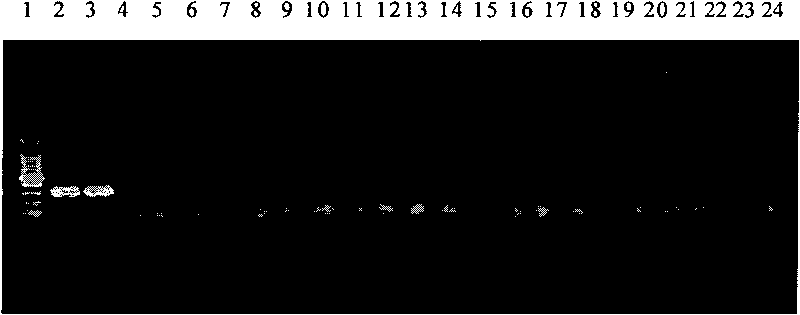Method for checking cucumber fusarium axysporum molecules
A technology for the detection of Fusarium wilt of cucumber and molecular detection is applied in the directions of microorganism-based methods, biochemical equipment and methods, and microbial determination/inspection. The effect of high stability and stability, not easy to contaminate
- Summary
- Abstract
- Description
- Claims
- Application Information
AI Technical Summary
Problems solved by technology
Method used
Image
Examples
specific Embodiment approach 1
[0016] Specific embodiment one: present embodiment cucumber fusarium wilt molecular detection method is realized by the following steps: one, according to the characteristics of the ribosome transcribed spacer (ITS) DNA sequence of cucumber fusarium wilt, design a Fusarium wilt tool specific amplification effect For primers Fc-1 and Fc-2; 2. Extract the genomic DNA of the infected sample, and use primers Fc-1 and Fc-2 to carry out PCR amplification of the genomic DNA; 3. Put the PCR amplification product in 1.0% of GelRed dye Use 1×TAE buffer for electrophoresis on the agarose gel. After the electrophoresis, analyze it with a gel imaging system. If a specific band appears at 315bp, the infected sample contains Fusarium wilt, and the detection is completed; the Fc in step 1 -1 is 5`-CATACCACTTGTTGCCTC-3`, Fc-2 is 5`-ATTAACGCGAGTCCCCACC-3`; PCR amplification reaction system in step 2: 25μl reaction system, 2.5μl of 10×PCR buffer (200mM Tris-HCl pH 8.4, 200mM KCl, 100mM (NH 4 ) ...
specific Embodiment approach 2
[0022] Specific embodiment two: what this embodiment is different from specific embodiment one is that the ribosome transcribed spacer (ITS) DNA sequence of cucumber fusarium wilt bacterium in step 1 is:
[0023] cataccactt gttgcctcgg cggatcagcc cgctcccggt aaaacgggac ggcccgccag
[0024] aggacccccta aactctgttt ctatatgtaa cttctgagta aaaccataaa taaatcaaaa
[0025] ctttcaacaa cggatctctt ggttctggca tcgatgaaga acgcagcaaa atgcgataag
[0026] taatgtgaat tgcagaattc agtgaatcat cgaatctttg aacgcacatt gcgcccgcca
[0027] gtattctggc gggcatgcct gttcgagcgt catttcaacc ctcaagcaca gcttggtgtt
[0028] gggactcgcgttaat. Other steps and parameters are the same as those in Embodiment 1.
specific Embodiment approach 3
[0029] Embodiment 3: The difference between this embodiment and Embodiment 1 or 2 is that the genomic DNA of the infected sample is extracted in step 2 by freezing 20 mg of the infected sample at -70°C for 3 hours, taking it out and putting it into a sterilized mortar for grinding , add 500μl of TES buffer (100mM Tris, pH8.0, 10mM EDTA, 2% SDS, 100μg proteinase K), then transfer the solution into a centrifuge tube and incubate in a 60°C water bath for 1h, take it out and add 140μl of 5M NaCl and 65 μl of 10% CTAB, then put it in a 65°C water bath and incubate for 10 minutes, then add 700 μl of chloroform and place it at 0°C for 30 minutes, take it out and centrifuge at 4°C for 10 minutes, transfer the upper layer solution to a new sterilized centrifuge tube, and add RNA Add 5 μl of enzyme, incubate at 37°C for 1 hour, add 510 μl of isopropanol and place on ice for 30 minutes to precipitate DNA, then centrifuge at 4°C and 12,000 r / min for 10 minutes, collect the precipitate, and...
PUM
 Login to View More
Login to View More Abstract
Description
Claims
Application Information
 Login to View More
Login to View More - R&D
- Intellectual Property
- Life Sciences
- Materials
- Tech Scout
- Unparalleled Data Quality
- Higher Quality Content
- 60% Fewer Hallucinations
Browse by: Latest US Patents, China's latest patents, Technical Efficacy Thesaurus, Application Domain, Technology Topic, Popular Technical Reports.
© 2025 PatSnap. All rights reserved.Legal|Privacy policy|Modern Slavery Act Transparency Statement|Sitemap|About US| Contact US: help@patsnap.com



